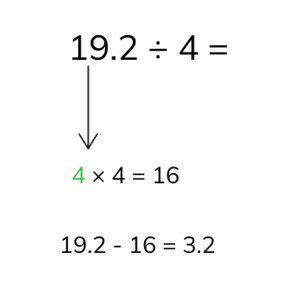



8,000 schools use Gynzy
92,000 teachers use Gynzy
1,600,000 students use Gynzy
General
The students learn to divide numbers with 1 or 2 decimal places by a whole number.
Standards
CCSS.Math.Content.5.NBT.B.7
Learning objective
Students will be able to divide decimal numbers with 1 of 2 decimal places by a whole number.
Introduction
Show a few numbers on the interactive whiteboard, for which the students must determine what the half is. Next they add these numbers together and determine the half of that answer.
Instruction
First explain how you can divide a decimal number with one decimal place by a whole number. You can do this in different ways. Explain that you can do this by first counting the digits behind the decimal point. After that, solve the problem without the decimal point. Next you put the decimal point back in the correct place. You can also first solve with the number in front of the decimal point. See how many times the divisor fits in this number. Next find how much you have left over. You cannot divide this number by the divisor, so you write down the answer with a decimal point. Then you solve further with the remaining number, for which you imagine that the decimal point is not there. Solve how many times the divisor fits in that number. You put the outcome of this calculation behind the decimal point. Have the students practice solving a few problems with decimal numbers with one decimal place. Ask the students how they solved the problems. Next you explain that you can use the same methods to solve a problem with a decimal number with two decimal places. So first count the number of digits behind the decimal point, solve the problem without the decimal point and then put the decimal point back in the correct place. Or first solve with the number in front of the decimal point and then with what you have left over, for which you imagine that the decimal point is not there. Have the students practice solving problems with a decimal number with two decimal places. Next you show a number of problems with decimal numbers with one or two decimal places. The students must solve these problems. Then drag the cover on the calculator away to check what the correct answers are. Finally you explain how you solve a story problem and have the students practice a few problems in the form of a story.
Check whether the students can divide decimal numbers by a whole number by asking the following questions:
- What steps do you take to be able to divide a decimal number?
- How do you solve the following problem: 92.4 ÷ 7?
Quiz
The students test their understanding of dividing decimal numbers through ten exercises. In each of these exercises, the students must divide a decimal number with one or two decimal places by a whole number. Some of the exercises are story problems.
Closing
You discuss with the students that it is important to be able to divide a decimal number with one or two decimal places, so that you know how much everyone gets if you want to divide something evenly. Next you have the students work in pairs to solve problems while competing against one another. First each pair draws a line with five dots on it. Next you show the first problem on the interactive whiteboard. The student that solves the problem first can move their placeholder (a chip or block) to the next point. After that the students try to solve the second problem, and so on. After five problems, the student that moved their placeholder the farthest wins.
Teaching tips
Students that have difficulty with dividing decimal numbers by a whole number can first practice dividing larger numbers without a decimal point. Next you show how you can solve a similar problem with a decimal point, by adding the number of digits behind the decimal point (84.91 ÷ 7, this problem has 2 digits behind the decimal point). Show where you should put the decimal point back in the answer.
Instruction materials
Placeholders, in the form of chips or blocks, to use in the closing activity
The online teaching platform for interactive whiteboards and displays in schools
Save time building lessons
Manage the classroom more efficiently
Increase student engagement
Discover more!
About Gynzy
Gynzy is an online teaching platform for interactive whiteboards and displays in schools.
With a focus on elementary education, Gynzy’s Whiteboard, digital tools, and activities make it easy for teachers to save time building lessons, increase student engagement, and make classroom management more efficient.



